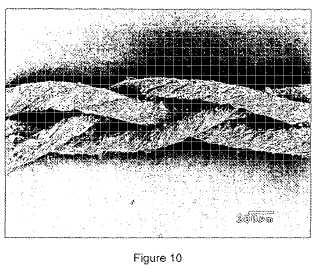Tissue Repair Scaffold
A tissue repair scaffold comprising a secondary fibre bundle, the secondary fibre bundle comprising a plurality of primary fibre bundles, each primary fibre bundle comprising a plurality of fibres, wherein the fibres comprise a biocompatible polymer. In embodiments the biocompatible polymer is polycaprolactone (PCL) (also known as poly-[epsilon]-caprolactone) and the average diameter of the fibres is less than 1 [mu]m. The scaffold is particularly adapted for tendon repair.Conventional approaches to the repair of tissue damage and assisting in the recovery from such damage are not comprehensive and have a number of drawbacks. Thus, tissue damage, and particularly damage to tendons, represents a significant challenge.
Tendons are a form of connective tissue and possess great flexibility and elasticity, which allow forces generated by muscle contraction to be transmitted to the attached bone, enabling movement. As a result of their ability to absorb external forces, tendons are able to act as a buffer, helping to prevent injury to the attached muscle.
Natural tendon is an example of a highly organised hierarchical tissue. It is principally composed of aligned collagen type I fibres with tenocytes arranged in rows between these fibres. Mechanical properties of tendons differ depending on their location within the body. In vivo studies on human Achilles' [Magnusson S P et al 20031 and tibialis anterior [Maganaris C N, 1999] tendons yielded moduli of 788 MPa and 1.2 GPa and tensile strengths 36.5 MPa and 25 MPa respectively. However, testing was not performed to rupture and can only be used as a guide.
All tendons have the potential to be affected by direct damage caused by lacerations or other accidental injuries. They are also susceptible to diseases. Clinically, tendon disorders are referred to as a "tendinopathy" as this makes no assumption as to the pathological processes within the tendon, although the term "tendonitis" is still used.
Of particular concern are tendinopathies within the Achilles tendon, which cause degeneration of the tissue. These are often the result of excessive and repetitive over-loading of the Achilles tendon in both sporting and sedentary patients.
Other tendons prone to pathology include the rotator cuff in the shoulder, where degeneration and the size of tears typically increases with age, and the patella tendon in the knee, which exDeriences degeneration due to excessive load bearing and strain rather than inflammatory tendinitis.
Attached files:

Patents:
GB 2,466,073
Inventor(s): DOWNES SANDRA [GB]; BOSWORTH LUCY ANN [GB]
Type of Offer: Sale
« More Medical Patents
